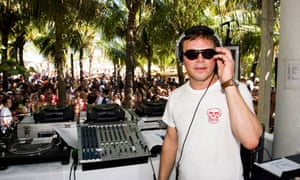Well, the party had to end sometime. The phenomenal rise of electronic dance music (EDM) may have entered a new, more mature phase, according to DJs and industry experts.
After almost a decade of growth, in which the subculture has entered the mainstream, the size of the global EDM market dropped 2% to £5.5bn last year – its first ever fall.
An annual state-of-the industry report presented at the International Music Summit (IMS) in Ibiza last week, which examined everything from recorded music sales to DJ earnings, club and festival revenues and merchandising, suggests the industry is in rude health in Asia but is losing market share in the US and Europe.
Kevin Watson, founder of Danceonomics, a knowledge hub for the electronic music industry, and the author of the report, said that, given such success, it was not surprising that appetite for the genre would eventually stall. “I think there’s still plenty of room for growth going forward. There’s been a slight dip but that’s to be expected, and the numbers still remain very positive on what the future looks like.”
The rise of EDM has been powered by technology, with social media helping build the profiles of emerging artists such as the Belgian techno DJ Amelie Lens. It has also transformed the music distribution model.
“Kids in their bedrooms can – pretty much for free – produce their own electronic music track and distribute it instantly,” Watson said. “And there’s lots of people out there that are now doing this and becoming very successful, because there are now almost zero investment costs.”
Watson’s report will be seen in some quarters as confirmation that the long-predicted bursting of the EDM bubble has finally happened.

But those within the industry suggest the picture is more nuanced. Pete Tong, the DJ and co-founder of the International Music Summit, told Music Week that the bubble had “punctured” rather than burst.
“I guess another analogy would be: ‘The party’s over, it’s now time to really get your hands dirty, get back to work and look after this business you’ve built for this level and get it to the next phase’,” Tong said.
Watson agreed, noting that as electronic music (he eschews the EDM label, arguing it has become synonymous with the commercial side of the genre) has teamed up with mainstream artists and festivals, its impact has become disguised. “You see a lot of tracks that are produced with DJs collaborating with other artists and a lot of those are being classified as pop or R&B,” he said. “They’re not getting registered in electronic music’s share of sales. Another thing we’re seeing is a lot of mainstream festivals like Coachella, which we wouldn’t normally term electronic music festivals, are booking a lot of electronic music DJs and artists.”
Recent examples of mainstream acts teaming up with EDM artists include Coldplay and the Chainsmokers, Justin Bieber’s work with Skrillex and Diplo and Ariana Grande’s collaboration with the DJ and producer Zedd.
Conversely, as other music genres assimilate it, parts of the electronic music movement have gone more underground.
“Quite often when things become much more populist and commercial, a lot of people become more focused on the underground, and that experiences a renaissance as well,” Watson said. “People might read about Coldplay and the Chainsmokers and the latest smash hit, but actually there’s a lot of stuff going on across the industry and there’s plenty of room for everyone to champion their particular sound.”
Tom Faber, a DJ and music critic, predicts that the genre, whose roots lie in 1970s artists such as Kraftwerk and King Tubby, will continue to mutate. “Electronic music has been a thing over the last 40 years: it’s always going in and out of the mainstream. It’s one of the genres that’s always coming back. For me, electronic music is always looking forward, always doing something new.”
For EDM’s superstar DJs, the industry continues to be a cash cow. Forbes estimates that Calvin Harris earned £37m last year while Tiesto took home £29m.